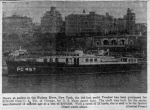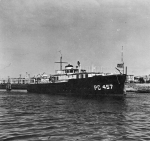In the early morning hours of 13 August 1941, the freighter Norluna was off the north coast of Puerto Rico, en route from St. Thomas to Santiago, Chile, when she encountered the patrolling PC-457. Abut a half hour before the collision, the patrol craft had approached Norluna and then moved off. She then approached Norluna again. In the words of Third Mate Kelly F. O'Neal:
"[I was] under the impression she was a pleasure boat the first time she approached…she was riding low in the water. They were hollering and seemed to be a noisy crowd. It sounded like there was a party on board. The patrol boat was about thirty feet from the Norluna's port side and they asked me to spell out our name on the blinker. Before I started working the blinker I yelled to the man at the wheel 'to get the hell away from the side of the ship.'
I had spelled as far as N-O-R when I heard the motors roar and saw her stern disappearing in front of the bow. I reached around and pulled the signal for the engine room to put her full speed astern. I did that as a measure of safety, but we struck."
Norluna's master, Captain David F. Atwood, testified:
"I had turned in between 10.15 and 10.30 and when the crash occurred at 11.52, I was wakened by vibration of the ship, which told me we were backing at full speed. There also was shouting and confusion. I immediately ran to the pilothouse. I could see the patrol boat, and we were still in contact with her. I swung the switch for the alarm and the men turned out and reported to boat stations. Visibility was good, with moderate to fresh winds. The sea was choppy and there was a slight swell running. I ordered the engine stopped and sent the third mate to launch a lifeboat. Soon after the engine stopped the patrol boat began to drift away. I out the searchlight on her and kept her in sight for two and a half hours until she finally sank. I could see the men in the water. My crew first threw ring buoys, life preservers, rope ends and cuts-anything that would float-over the side to the men swimming around. The ship was maneuvered as close as possible to the wreckage and survivors and the No. 1 lifeboat was swung and it began to pick up the survivors from the water and rafts.
The lifeboat was water-borne by 12 o'clock, approx. Eight minutes after the crash. It returned at 12.34 with the captain and fifteen men of the crew. A dinghy from the patrol boat also came alongside with five men aboard her. One man was injured. He had minor cuts on his arm and abdomen. He was transferred along with the others to other boats and taken in." Muster was called by the patrol boat CO, Lieutenant Campbell, when the no. 1 lifeboat came alongside and it was then discovered that two men were missing. The boat went out again and returned at 1.32 A.M."
ENS Ralph F. Locke, USNR, executive officer of PC-457, reported:
"I still don't remember all that happened in those few short minutes. First there was the crash. The whole boat trembled and immediately began sinking so fast that nothing could be done.
Within five minutes after the crash occurred our vessel had sunk. The crew was forced to abandon the ship immediately-few of them having time to don lifebelts or launch the lifeboats. There were about eleven Baltimore reservists aboard our boat. All except McKenna and Osborn were saved. None of us were injured. I don't know how long we were floundering in the water before the rescue boats picked us up. The USS Mankato (YN-40), the Coast Guard cutter Marion (WSC-145) and a tugboat picked us up."
|
 Two men died in service aboard and remain on duty
Two men died in service aboard and remain on duty






